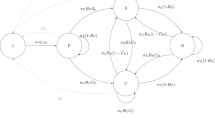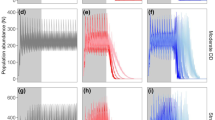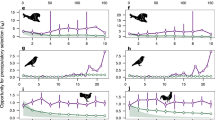Abstract
Behavioural and life history polymorphisms are often observed in animal populations. We analyse the timing of maturation and reproduction in risky and resource-limited environments. Field and laboratory evidence suggests that female voles and mice, for example, can adjust their breeding according to the level of risk to their own survival and to survival probabilities and recruitment of young produced under different environmental conditions. Under risky or harsh conditions breeding can be postponed until later in the current breeding season or even to the next breeding season. We develop a population dynamics and life history model for polymorphism in reproduction (co-existence of breeding and non-breeding behaviours) of females in an age-structured population, with two temporally distinct mating events within the breeding season. We assume that, after overwintering, the females can breed in spring and again in summer or they can delay breeding in spring and breed in summer only. Young females born in spring can either mature and breed in summer or stay immature and postpone breeding over the winter to the next breeding season. We show that an evolutionarily stable breeding strategy is either an age-structured combination of pure breeding behaviours (old females breed and young delay maturity) or a mixed breeding behaviour within age-classes (a fraction of females breed and the rest of the age class postpones breeding). Co-occurrence of mixed reproductive behaviour in spring and summer within a single breeding season is observed in fluctuating populations only. The reproductive patterns depend on intraspecific, possibly interspecific, and ecological factors. The density dependence (e.g. social suppression) and predation risk are shown to be possible evolutionary mechanisms in adjusting the relative proportions of the different but co-existing reproductive behaviours.
Similar content being viewed by others
References
Boonstra, R. and Rodd, F.H. (1983) Regulation of breeding density in Microtus pennsylvanicus. J. Animal Ecol. 52, 757–80.
Bujalska, G. (1973) The role of spacing behaviour among females in the regulation of reproduction in the bank vole. J. Reproduct. Fertil. Suppl. 19, 461–72.
Bujalska, G. (1985) Regulation of female maturation in Clethrionomys species, with special reference to an island population of C. glareolus. Ann. Zool. Fenn. 22, 331–42.
Bujalska, G. (1990) Social system of the bank vole, Clethrionomys glareolus. In Social Systems and Population Cycles in Voles (R.H. Tamarin, R.J. Ostfeld, S.R. Push and G. Bujalska, eds), pp. 155–67. Birkhauser Verlag, Berlin.
Charlesworth, B. (1980) Evolution in Age-structured Populations. Cambridge University Press, Cambridge.
Cushing, B. (1985) Estrous mice and vulnerability to weasel predation. Ecology 66, 1976–8.
Edelstein-Keshet, L. (1989) Mathematical Models in Biology. Random House, New York.
Ellner, S. (1985a) ESS germination strategies in randomly varying environments. I. Logistic-type models. Theor. Pop. Biol. 28, 50–79.
Ellner, S. (1985b) ESS germination strategies in randomly varying environments. II. Reciprocal yield-law models. Theor. Pop. Biol. 28, 80–116.
Fairbairn, D.J. (1977) Why breed early? A study of reproductive tactics in Peromyscus. Can. J. Zool. 55, 862–71.
Felsenstein, J. (1979) r-and K-selection in a completely chaotic population model. Am. Nat. 113, 499–510.
Ferriére, R. and Clobert, J. (1992) Evolutionary stable age at first reproduction in a density-dependent model. J. Theor. Biol. 157, 253–67.
Ferriére, R. and Gatto, M. (1993) Chaotic population dynamics can result from natural selection. Proc. R. Soc. Lond. B 251, 33–8.
Gatto, M. (1993) The evolutionary optimality of oscillatory and chaotic dynamics in simple population models. Theor. Pop. Biol. 43, 310–36.
Getz, W.M. and Kaitala, V. (1993) Ecogenetic analysis and evolutionary stable strategies in harvested populations. In The Exploitation of Evolving Resources. Lecture Notes in Biomathematics, Vol. 99 (T.K. Stokes, J.M. McGlade and R. Law, eds), pp. 187–203. Springer-Verlag, Berlin.
Hansson, L. and Henttonen, H. (1988) Rodent dynamics as community process. Trends Ecol. Evol. 3, 195–200.
Hastings, A. (1978) Evolutionary stable strategies and the evolution of life history strategies: I. Density dependent models. J. Theor. Biol. 75, 527–36.
Henttonen, H. (1987) The impact of spacing behaviour in microtine rodents on the dynamics of least weasels Mustela nivalis — a hypothesis. Oikos 50, 366–70.
Hines, W.G.S. (1987) Evolutionary stable strategies: a review of basic theory. Theor. Pop. Biol. 31, 195–272.
Kaitala, V. (1990) Evolutionary stable migration in salmon — a simulation study of homing and straying. Ann. Zool. Fenn. 27, 131–38.
Kaitala, V. and Getz, W.M. (1995) Population dynamics and harvesting of semelparous species with phenotypic and genotypic variability in reproductive age. J. Math. Biol. 33, 521–56.
Kaitala, V., Kaitala, A. and Getz, W.M. (1989) Evolutionary stable dispersal of a waterstrider in a temporally and spatially heterogeneous environment. Evol. Ecol. 3, 283–98.
Kaitala, A., Kaitala, V. and Lundberg, P. (1993) A theory of partial migration. Am. Nat. 142, 59–81.
Kawata, M. (1987) Pregnancy failure and suppression by female-female interaction in enclosed populations of the red-backed vole, Clethrionomys rufocanus bedfordiae. Behav. Ecol. Sociobiol. 20, 89–97.
Korpimäki, E., Norrdahl, K. and Rinta-Jaskari, T. (1991) Response of stoats and least weasels to fluctuating food abundances: is the low phase of the vole cycle due to mustelid predation? Oecologia 88, 552–61.
Korpimäki, E., Norrdahl, K. and Valkama, J. (1994) Reproductive investment under fluctuating predation risk: microtine rodents and small mustelids. Evol. Ecol. 8, 357–68.
Koskela, E. and Ylönen, H. (1995) Suppressed breeding in the field vole (Microtus asrestis): an adaptation to cyclically fluctuating predation risk. Behav. Ecol. 6, 311–15.
Maynard Smith, J. (1976) Evolution and the theory of games. Am. Sci. 64, 41–5.
Maynard Smith, J. (1982) Evolution and the Theory of Games. Cambridge University Press, New York.
Metz, J.A.J., Nisbet, R.M. and Geritz, S.A.H. (1992) How should we define ‘fitness’ for general ecological scenarios? Trends Ecol. Evol. 7, 198–202.
Mylius, S.D. and Diekmann, O. (1995) On evolutionary stable life histories, optimization and the need to be specific about density dependence. Oikos 74, 218–24.
Nordahl, K. (1993) Regulation of cyclic small mammal populations by avian and mammalian predation. PhD dissertation, University of Helsinki, Helsinki.
Orzak, S.H. and Tuljapurkar, S. (1989) Population dynamics in variable environments. VII. The demography and evolution of iteroparity. Am. Nat. 133, 901–23.
Peitgen, H.-O., Jürgens, H. and Saupe, D. (1992) Chaos and Fractals. Springer-Verlag, New York.
Rand, D.A., Wilson, H.B. and McGlade, J.M. (1994) Dynamics and evolution: evolutionary stable attractors, invasion exponents and phenotypic dynamics. Phil. Trans. R. Soc. Lond. B 343, 261–83.
Reznick, D. (1992) Measuring the costs of reproduction. Trends Ecol. Evol. 7, 42–5.
Roff, D.A. (1992) The Evolution of Life Histories. Theory and Analysis. Chapman & Hall, New York.
Saitoh, T. (1981) Control of female maturation in high density populations of the red-backed vole, Clethrionomys rufocanus bedfordiae. J. Animal Ecol. 50, 79–87.
Stearns, S.C. (1992) The Evolution of Life Histories. Oxford University Press, Oxford.
Teferi, T. and Millar, J.S. (1993) Early maturation by northern Peromyscus maniculatus. Can. J. Zool. 71, 1743–7.
Wasser, S.K. and Barash, D.P. (1983) Reproduction suppression among female mammals: implications for biomedicine and sexual selection theory. Q. Rev. Biol. 58, 513–38.
Ylönen, H. (1989) Weasels Mustela nivalis suppress reproduction in cyclic bank voles Clethrionomys glareolus. Oikos 55, 138–48.
Ylönen, H. (1994) Vole cycles and antipredatory behavior. Trends Ecol. Evol. 9, 426–30.
Ylönen, H. and Ronkainen, H. (1994) Breeding suppression in the bank vole as antipredatory adaptation in a predictable environment. Evol. Ecol. 8, 658–66.
Author information
Authors and Affiliations
Rights and permissions
About this article
Cite this article
Kaitala, V., Mappes, T. & Ylonen, H. Delayed female reproduction in equilibrium and chaotic populations. Evolutionary Ecology 11, 105–126 (1997). https://doi.org/10.1023/A:1018491630846
Issue Date:
DOI: https://doi.org/10.1023/A:1018491630846




